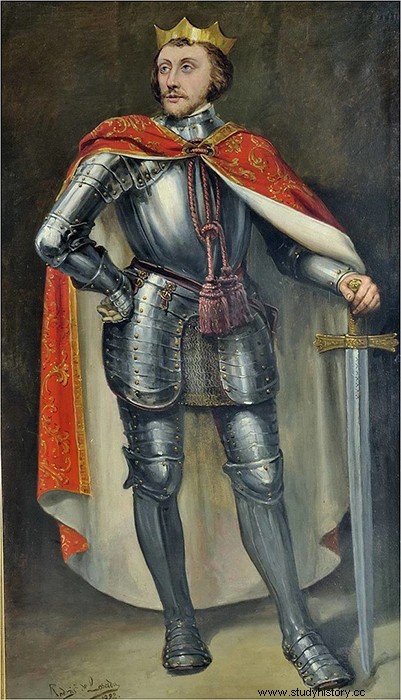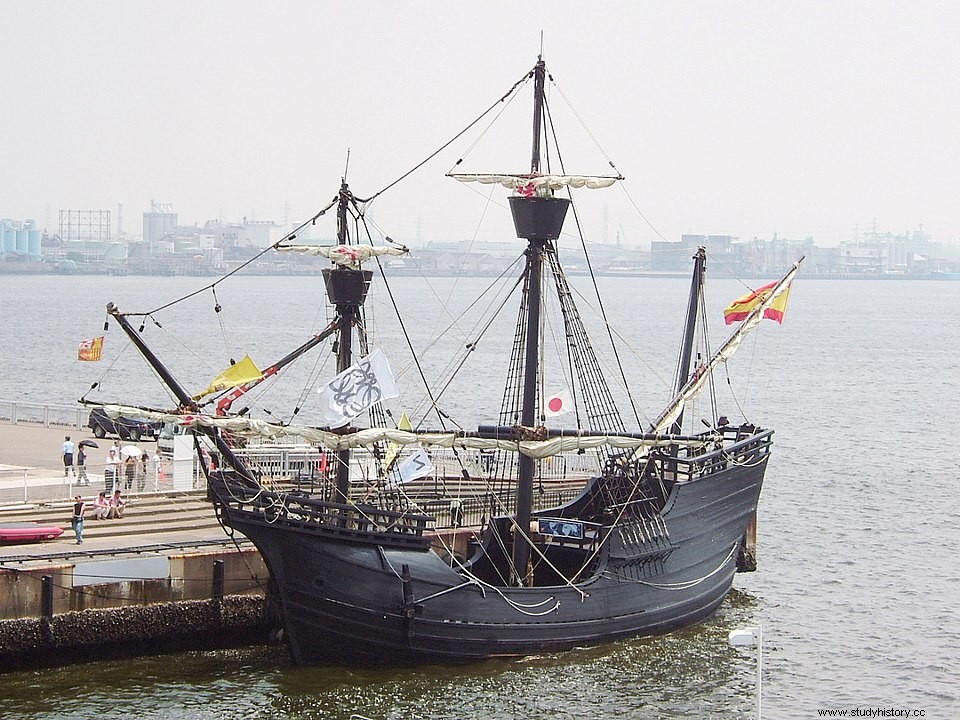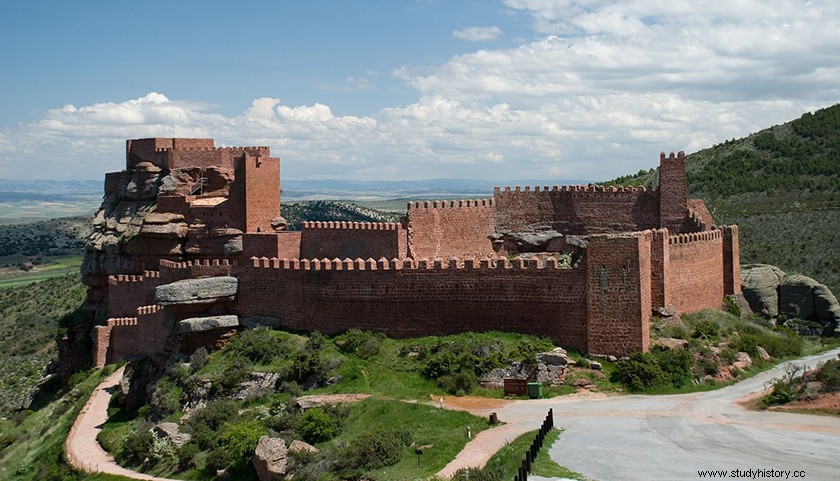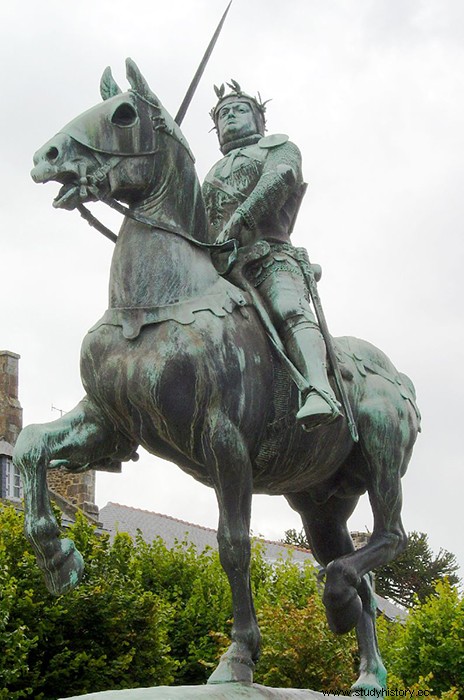
In the middle of the fourteenth century the peninsula was divided into five different kingdoms. One of them, Portugal , licked the wounds of his last civil wars. Meanwhile, Navarra he was content to meddle in the affairs of France, his neighbor to the north, from her shrinking territories. If we look to the south we find the Kingdom of Granada , the subject Muslim vassals of Castile, with the simple dream of continuing to maintain the lands inherited from their predecessors.
We have two left; the Kingdom of Castile , the largest territorially and the Crown of Aragon , with its continuous sights on its Mediterranean expansion. Both decide to risk the supremacy of the Peninsula in an inconsequential War of the Two Pedros , which ended as it began, at least politically. But that laid the foundations for a dynastic union that would take another century and a half to bear fruit, the birth of Spain as we know it today.

The Iberian Peninsula during the War of the Two Pedros.
In hindsight we can think that this war did not come at the best of times, if there ever was one. Western Europe was going through a bloody crisis, plunged into the Hundred Years' War between French and English that dotted the Hispanic kingdoms. In addition, the ravages of the reviled black plague, continued. that had decimated the European population between 1348 and 1353. War and plague brought famine and social conflicts between the different layers of late medieval society.
The protagonists of the War of the Two Peters.
Peter I of Castile, 1350-1369.

Pedro I of Castile
Son of Alfonso XI, he was only 16 years old when he came to power, facing the problem left by his father. Nothing more, and nothing less, than ten bastard brothers, born from the marriage between Alfonso and Leonor de Guzmán. Pedro I, nicknamed “the cruel one”, dedicated a good part of the first years of his reign to ending the bastard claimants to his crown. With the exception of Enrique de Trastámara , who sought foreign support for his cause. This is how he got Castile into the Hundred Years' War. That is to say, Pedro I found himself mired in three wars, the one imported from Europe, the home war against his stepbrother and the one between the Two Pedros, with Aragon. None of the three can be dissociated from the rest, what's more, as we will see, they mix continuously.
Peter IV of Aragon, 1336-1387.

Peter IV of Aragon
Pedro IV, like his Castilian namesake, came to power as the Crown of Aragon at a time when the Valencian and Aragonese nobility were trying to reach high levels of political power. Hence the first years of his reign were devoted to stamping out the insurgency of the High Nobility. Period where he earned one of his nicknames; “El del puñalet”, won after tearing in front of the people of Zaragoza, the privileges granted by his predecessors to the Aragonese nobles. But his great sights were set on the conquest of the Mediterranean; Mallorca, Sicily, Sardinia and even Athens were under the rule of the Crown of Aragon, during the reign of this monarch born in Balaguer.
The beginnings of the War between the Two Peters.

As has been said, the War between the Two Peters , cannot be dissociated, neither from the Castilian Civil War, nor from the Hundred Years' War. The pre-war climate between both crowns was very present in the 14th century. Pedro I of Castile accused his counterpart of protecting the interests of his bastard brothers, including Fernando de Trastámara . But the Castilians were not without blame, since since 1348 Fernando de Aragón, the leader of the Aragonese nobility revolt against Pedro IV and who continued to aspire to his throne, had been a refugee in the lands of Castile.
Furthermore, Aragon's Mediterranean claims collided directly with those of the Republic of Genoa traditional political and economic ally of Castile. As if that were not enough, within the Castilian heart the Treaty of Elche (1305) continued to sting, by which the monarch of Castile, Fernando IV, ceded large territories of Murcia and the south of Alicante to the Crown of Aragon.
With all this, the incident that occurred in the waters of Cadiz, may sound like an excuse to us. Some allied ships of Genoa were captured near Sanlúcar de Barrameda by Catalan ships of the Crown of Aragon. The incident, by chance, was in the presence of the Castilian King Pedro I. Immediately afterwards Castile imposed severe restrictions on the Catalan merchants settled in its territory, seizing all their assets, and issuing an ultimatum to the King of Aragon. He picks up the thrown gauntlet and war is served.
The first important war action was the siege of Alicante by the Castilian troops in September 1356. The city seems to have been taken, but in no case was it consolidated the conquest, the Castilian army was expelled by the people of Alicante a few days later.
In the Aragonese part the ingenuity of their king began to work to launch diplomacy. Pedro IV of Aragon has gone down in history as a strategist of the offices. At the end of that same year, he signs the Treaty of Pina with the Castilian insurgent Enrique de Tratámara , to whom he ceded several territories belonging to Fernando de Aragón, in order to win the vassalage of the pretender to the Crown of Castile. He also acts as a guide to an internal rebellion in Castile, by supporting a part of the Andalusian nobility in their uprising against Pedro I.
Faced with such movements, the Castilian king, and after placating the Andalusian revolt, decides to launch the first truce, supported by the papal legate. The signing took place in Navarrese territories, specifically in Tudela. The King of Castile was clear, he needed time to put an end to any hint of internal revolt, knowing that on the battlefield he was superior to Aragon.
It was the period where the King of Castile earned the nickname "the cruel one". Consecutively he finished with Fadrique , Master of the Order of Santiago, and twin brother of Enrique de Trastámara. John of Aragon , another of his bastard brothers and lord of Vizcaya. Next on the list was Eleanor of Castile , her own aunt and mother of Fernando de Aragón. With what Pedro I earned the enmity of even his own followers, the Aragonese infantryman deserted, returning to his land and putting himself at the service of Pedro IV.
Vindicated a Castilian fleet.
If Castile had more power on land, Aragon had its fort in the sea, the Aragonese fleet in the mid-fourteenth century controlled much of the Western Mediterranean. Pedro I, thought that it was time to, at least, equalize the contest.

Replica of the Nao Victoria, with which Magellan sailed around the world. These types of ships originated in the 14th century, and were part of the Castilian fleet that sailed the Mediterranean during the War of the Two Peters.
His Portuguese contacts of him promised help. He also found the support of his faithful ally Genoa, several Genoese, seasoned sailors, commanded the Castilian ships that were manufactured between 1358-1359 in the ports of Seville and the Bay of Biscay. Castilla sent more than a hundred ships against Barcelona, they failed to land, but at least they managed to divert Aragon's attention from Genoa. Then the attack was launched against Ibiza, with the same result. The Castilian fleet retreated to their posts, they did not achieve anything, but at least they achieved their presence in the Mediterranean for the first time.
Enrique de Trastámara takes action.
Until then, Pedro I's Castilian rival had been waiting for an opportunity. He found it in September 1359, while the Castilian king was analyzing the opportunities of his renewed army. Henry of Trastamara he financed an expedition to Castile with Aragonese support. The chosen place was the countryside of Soria, the small town of Ólvega was razed to the ground. Immediately afterwards, the Castilian border troops of Soria, including those of Almazán, Gómara and Agreda, set out to stop the invasion. The meeting took place on the slopes of Moncayo, in a place known as la Araviana . The Castilian defeat was resounding, some of its leaders died, others were imprisoned, and the rest fled to Aragon fearful of reprisals from Pedro I.
The Aragonese king decides to take advantage of the victory of his ally. He sets course for the town of Tarazona, one of the strongest border towns of the Castilian army. Upon his arrival, the gates of the city are opened to him, due to the desertion of the captain of the Castilian garrison.
After both victors meet, Enrique de Trastámara leads the Aragonese army to his land. His purpose was to invade Castile. Pedro IV, takes him at his word and they prepare the ground assault, in a few days the Aragonese army is planted in the vicinity of the Pancorbo gorge .
In this way Pedro I is forced to abandon his Mediterranean adventure. The new meeting between Castilians and Aragonese took place near Nájera. In this case the victory favored the most powerful contender in heads-up. Henry of Trastamara he was forced to take refuge in the current city of La Rioja and escape from it through the back door to preserve his life.
The Peace of Terrer.
It seemed clear that Aragon could not beat Castile. In addition, the latter decide to strengthen their international allies. With Portugal they reach a pact for the return of political opponents, Castilian nobles are returned from Portugal to Castile. While others make the trip in reverse, that is, Portuguese nobles from Castile to Portugal. The common fate of all, execution without trial.
The other Castilian pact is with England. For this reason, Castilla was fully involved in the Hundred Years' War on the winning side, since, in the year 1360, the English appeared to have a clear advantage over the French in the eternal war, although at that time it was in a truce.
On the opposite side, Aragon could only sue for peace. His inferiority to his rival led him to the need to reinforce the entire border line, from Tarazona to Albarracín, from this period one of the most imposing castles I remember emerged, the Teruel Castle of Peracense. Peter I of Castile he was also in favor of this following truce, since a new enemy had arisen. It was in the south that the king of Granada was deposed and replaced by Muhammad VI, who had already signed a kind of pact to support the Crown of Aragon in the Spanish conflict.

The impressive Peracense Castle was remodeled during the War of the Two Pedros
Peace was signed in Terrer on May 13, 1361. For the same, the Castilian king renounced some of his territorial claims, in exchange for Pedro IV dispensing with the services of Enrique de Trastámara. The Aragonese king agreed, and Pedro I's rival was forced to take refuge in France.
Pedro I of Castile's great offensive.
Terrer's Peace it lasted as long as it took for the contenders to catch their breath. Pedro I, according to the sources, with his own hands ends the new king of Granada, Muhammad VI, replacing his predecessor in the post. With this he covered his back from an attack from Andalusian lands.
Then he prepares the most important military campaign of the entire war. Successively the border towns of Alhama, Ariza and Ateca are falling. Then after a terrible siege, in the harsh month of August, the city of Calatayud is conquered by the Castilian troops, from there to Zaragoza the road is clearer. But that was not the place chosen by Pedro I, apparently it was more daring for him to try to conquer the capital of the kingdom of Valencia, possibly seeking control of the Mediterranean. In the spring of 1363, the important squares of Teruel and Segorbe fell. Humiliated Aragon asks for a new truce, with the city of Valencia under siege.
The return of Enrique de Trastámara and the internationalization of the war.
The umpteenth peace signing took place in Sagunto. Useless as before. A few days after the signing, some secrets are revealed. The first to fall was the Infante Fernando de Aragón , who at that time was the main candidate for the throne of Castile before the death of Pedro I's heir. The murder only has one "presumed" culprit, the king of Aragon, in order to carry out a new secret pact with Henry of Trastamara . This had been signed between the two, three months earlier in the castle of Monzón. The Aragonese king recognized and supported Enrique, as the legitimate king of Castile, in exchange for large Castilian territories, such as Murcia and other areas of Soria, Cuenca and Molina.
In 1365 we find the turning point, which will give a new turn in the War of the Two Peters , by the way, after a curious alignment of characters. On the one hand, we find Peter IV of Aragon against the ropes, inside the besieged city of Valencia. On the other Enrique de Trastámara , now yes, the main candidate for the throne of Castile and a huge thirst for revenge for the murders of Pedro I. Only one ace was missing for the trio, France put it in the figure of Bertrand du Guesclin , who was ready to cross the Pyrenees at the command of an army of unemployed French mercenaries, after the Peace of Bretigny between these and the English.

Bertrand du Guesclin, statue in the city of Dinan, in French Brittany
From this point in the story it is increasingly difficult to guess if the War of the Two Peters was being fought , the Civil War of Castile, or even the taglines of the Hundred Years' War between the two European powers.
The end of the War of the Two Peters.
As of March 1366 we already find two kings of Castile. Pedro I and the newly self-appointed king in Calahorra, known as Henry II of Castile , which had the support of Aragon and, above all, of the French mercenaries who had crossed Navarra in order to reach Castile.

Henry II at the León City Hall
The first defections among the supporters of the legitimate king lead him to flee Burgos, where he was after fleeing the besieged city of Valencia. He headed for Andalusia, Portugal and Galicia, in search of support for his cause. But the final destination was the south of France, the French Aquitaine that was in the hands of the English. There he agreed to the help of Edward of Woodstock , known as Black Prince, in exchange for succulent portions of Castilian territory. In addition, he did not hesitate to leave his own daughters prisoners, as a guarantee of compliance with the agreements reached in Libourne.

The pact between the Black Prince and Pedro I, according to James William Edmund Doyle.
Only two months after the pact between Pedro I and the Black Prince, in February 1367 the so-called Second Battle of Nájera took place. . The result was identical to the first, Pedro I this time with the help of the English archers defeated the Trastámara, forced to flee to France again.
Aragon is in danger again, the potential of Castile is joined by the best army in Europe at the time. Everything is rushed, Pedro IV makes the quick decision to rescind his agreements with Henry II.

The Second Battle of Nájera, according to Jean Froissart.
But incomprehensibly Pedro I, throws everything overboard again, with everything in his favor, he makes enemies with his new English partner. This one does not see with good eyes the treatment dispensed by the Castilian king to his enemies behind the battlefield. He calls him cruel and bad payer, by not compensating with what was promised to the English troops. The Black Prince leaves Castile, but not before being the guarantor of the final peace between the Kingdom of Castile and the Crown of Aragon, signed on August 13, 1367.
The death of Pedro I, the Cruel.
The civil war in Castile continued the following year. In it, Enrique de Trastámara he again counted on French help. These had as a priority the victory of Henry II of Castile in the Civil War, to be able to count on the help of Castile in his war against England. The Castilian territories were plunged into enormous chaos, some cities supported Pedro I and others Enrique II, promoting wars and sieges everywhere. The popularity of Pedro I fell by leaps and bounds while he made a pact with the devil himself, in order to put an end to Trastámara. This is how new contingents of Muslims arrived on the Peninsula.
In this context the death of Peter I the Cruel took place . It took place in Montiel (Ciudad Real), where the French Bertrand du Guesclin arrived. for the sake of receiving a pact with the Castilian king, who offered him a huge amount of money and possessions if he changed sides. Along with it, he arrived at the battlefield tent Henry II, who killed Pedro I with his own hands.

The death of Pedro I "the Cruel", according to Arturo Montero y Calvo
A Trastámara inaugurated a new dynasty in the Kingdom of Castile, little more than half a century later, another Trastámara will take over the Crown of Aragon, it was less for the definitive union of Castilla y Aragón and the birth of Spain, as we know it today.
More info:
History of Spain in the Middle Ages, Cood. Vicente Ángel Álvarez Palenzuela, Ed. Ariel, 2011.
The Aragonese counteroffensive in the War of the Two Pedros, Antonio Gutiérrez de Velasco, 1963
https://historiaragon.com
